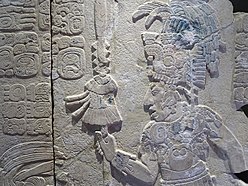
Back تاريخ المكسيك Arabic Historia de Méxicu AST Meksika tarixi Azerbaijani Гісторыя Мексікі Byelorussian মেক্সিকোর ইতিহাস Bengali/Bangla Istor Mec'hiko Breton Història de Mèxic Catalan Dějiny Mexika Czech Hanes Mecsico Welsh Mexicos historie Danish
| History of Mexico |
|---|
 |
| Timeline |
|
|

The written history of Mexico spans more than three millennia. First populated more than 13,000 years ago,[1] central and southern Mexico (termed Mesoamerica) saw the rise and fall of complex indigenous civilizations. Mesoamerican civilizations developed glyphic writing systems, recording the political history of conquests and rulers. Mesoamerican history before European arrival is called the prehispanic era or the pre-Columbian era. The Spanish conquest of the Aztec Empire established the colony of New Spain, leading to the imposition of Spanish rule over the indigenous populations, the spread of Christianity, the exploitation of natural resources, and the introduction of new crops, animals, and diseases.
A prolonged struggle ensued in order to attain independence against Spain. Social inequalities, necessity for economic growth (independent from Spain), and the spread of republican ideals free from European monarchies contributed to independence movements against Spain. These movements included the "Grito De Dolores (Cry of Dolores)," lead predominately by Catholic priest, Miguel Hidalgo. Hidalgo remained a prominent figure of the independence movement up until he was capture and execution by the Spanish. The events transpired by Hidalgo kickstarted the events which later contributed to Mexico's offical Declaration of Independence against Spain in 1821.
After the Mexican War of Independence (1810-1821), Mexico struggled to establish stability amid regional conflicts and power struggles among caudillos, competing factions, separatist movements, and foreign intervention. The mid-19th century Reforma saw efforts to modernize Mexican society, including the promotion of civil liberties and the separation of church and state. Yet, Mexico faced continued challenges, including the Reform War, French intervention (1861-1867), and the subsequent establishment of the short-lived Second Mexican Empire. The late 19th century Porfiriato (1876-1911) was characterized by economic growth but also marked by authoritarianism and social inequality. Long-standing grievances, including land dispossession, exploitation of labor, and lack of representation led to the Mexican Revolution in 1910. The revolution quickly escalated into a protracted conflict involving several factions, with the Constitutionalists emerging victorious in 1920.
After the Revolution, the Institutional Revolutionary Party emerged as the dominant political force, maintaining power through a combination of patronage, authoritarianism, and corporatism. In the following decades, Mexico implemented land reform, nationalized key industries, and expanded social welfare programs. However, political stability and economic growth were often marred by corruption, repression, and violence. Following economic crises in the 1970s and 1980s, policies shifted towards privatization and trade liberalization. The signing of the North American Free Trade Agreement in 1994 led to greater integration into the global economy, but also deindustrialization and social unrest. The end of the century saw the PRI's long-standing grip on power challenged, culminating in the opposition National Action Party (PAN) winning the presidency in 2000, marking a shift in Mexico's political landscape.
- ^ "Oldest American skull found", CNN, December 3, 2002
© MMXXIII Rich X Search. We shall prevail. All rights reserved. Rich X Search

